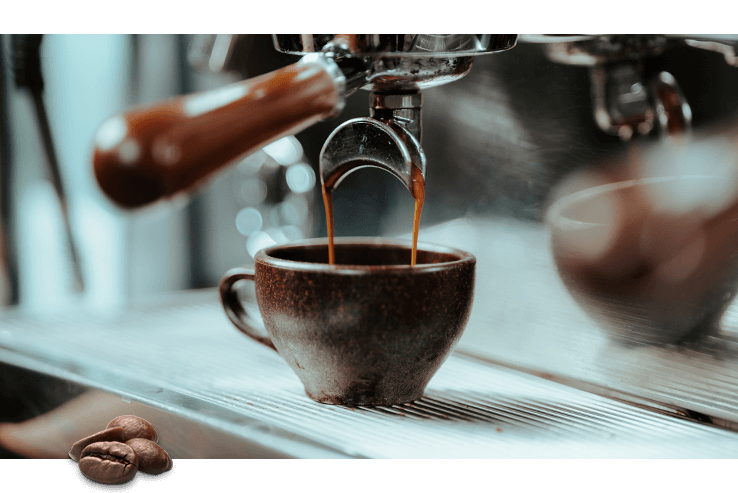SOE Single Origin Espresso – Perfect for Manual Brewing Methods
SOE Single Origin Espresso – Perfect for Manual Brewing Methods
Blog Article
Comprehending Coffee Beans: the Trip From Espresso to Blended Coffee Beans

The Beginnings of Coffee: An International Point Of View
While you might believe of coffee as a modern-day staple, its beginnings trace back centuries, linking with cultures throughout the globe. The story starts in Ethiopia, where legend states a goat herder called Kaldi found the energizing effects of coffee beans after observing his goats frolicking energetically after consuming them.
As profession courses expanded, coffee made its way to Europe in the 17th century, promptly getting popularity. Each society included its special twist to coffee prep work, improving its history.
Growing and Harvesting of Espresso Beans
As coffee's trip advanced, the emphasis changed to the growing and harvesting of details bean selections, specifically those used for coffee. You'll find that espresso beans commonly come from Arabica or Robusta plants, each offering unique tastes. The excellent expanding conditions consist of high elevations and rich, well-drained soil, which boost the beans' high quality.
Throughout the harvest, picking approaches differ. In some areas, workers hand-pick ripe cherries, guaranteeing just the most effective fruit mosts likely to processing. In other locations, mechanical farmers are used, especially on larger ranches. Timing is vital; you wish to harvest when the cherries get to peak ripeness for maximum taste.
When collected, the beans are gotten ready for handling, which is vital in determining their last preference. Understanding the cultivation and gathering procedures offers you understanding into what goes into your favorite espresso, enriching your appreciation for each cup.
Processing Methods: From Cherry to Bean
Now that you have actually discovered collecting espresso beans, allow's explore just how those cherries change right into the coffee beans you love. You'll see how different harvesting strategies impact flavor, complied with by the essential steps of fermentation and drying out. Finally, we'll damage down the milling and grading process that determines your coffee's quality.
Harvesting Strategies Described
When it comes to coffee, understanding harvesting strategies is important, since they directly impact the flavor and high quality of the beans you delight in. There are 2 main approaches: discerning picking and strip selecting. Careful choosing includes hand-picking just ripe cherries, ensuring you obtain the finest top quality beans. This technique commonly leads to a richer flavor profile, though it's even more labor-intensive. On the other hand, strip choosing ways gathering all cherries simultaneously, no matter ripeness. While it's quicker and cheaper, this can lead to a mix of flavors, influencing the last product. Eventually, the option of harvesting technique can considerably influence your coffee experience, so it's worth understanding just how those beans made it to your cup.
Fermentation and Drying
After gathering, the next steps in handling coffee beans play a considerable role in forming their flavor. You'll locate that fermentation is vital, as it assists break down the mucilage bordering the beans, boosting their taste profile. Relying on the method, this procedure can last from a few hours to numerous days, with differing results based on temperature level and humidity.
Once fermentation is complete, drying adheres to, which is equally crucial. You can choose from sun-drying or mechanical drying out approaches. Sun-drying permits the beans to soak up tastes from the environment, while mechanical drying guarantees constant moisture degrees despite weather. Correct drying is necessary to protect against mold and mildew and maintain the beans' high quality, ultimately affecting your cup of coffee.
Milling and Grading Refine
As fermentation and drying out set the phase for flavor advancement, the milling and grading process assurances that just the most effective coffee beans make it to your mug. This phase involves eliminating the outer layers of the coffee cherry, consisting of the parchment and husk. After milling, the beans are sorted by dimension and weight, guaranteeing a consistent top quality. You'll find that grading helps recognize problems and categorize beans, which affects flavor and scent. Premium beans obtain a higher quality, causing a richer coffee experience. When graded, the beans are all set for product packaging and delivery, maintaining their special attributes. This meticulous process is crucial for supplying the outstanding preference you appreciate in every sip of your favorite mixture.
Roasting Techniques: Opening Flavor Prospective
When you roast coffee beans, the approach you select can drastically affect the flavor account. Understanding the connection between time, temperature, and toasting techniques is vital to revealing the potential of your mixture. Allow's explore exactly how these aspects integrated to produce the ideal mug.
Toasting Approaches Described
While you could believe that all coffee roasting approaches produce the same results, the reality is that each method discloses one-of-a-kind taste possibilities in the beans. You can pick in between methods like drum roasting, air roasting, or perhaps typical frying pan roasting. Drum toasting makes use of a turning drum to equally distribute warmth, boosting caramelization and producing a well balanced flavor. Air roasting, on the other hand, distributes hot air around the beans, advertising a lighter roast with noticable level of acidity. Pan roasting permits hands-on control yet needs consistent attention to prevent burning. Each approach has its subtleties, so exploring with different techniques can aid you find the ideal roast that lines up with your preference preferences. Appreciate the trip of discovering your suitable cup!

Effect On Flavor Account
Different toasting approaches not only influence the procedure but likewise considerably influence the flavor profile of the coffee beans. When you select a light roast, you'll experience bright acidity and floral notes, showcasing the bean's beginning. In contrast, a tool roast balances acidity with sweet taste, often revealing chocolatey undertones. Dark roasts, on the various other hand, bring out bold, great smoky flavors, in some cases masking the bean's one-of-a-kind qualities. Each strategy reveals different oils and compounds, causing a large range of flavors. By exploring with different roasting designs, you can uncover which profiles reverberate with your taste buds. Recognizing these subtleties helps you appreciate the artistry behind your mug of coffee, enhancing your overall experience with every sip.
Time and Temperature Factors
To release the complete flavor possibility of coffee beans, both time and temperature throughout the roasting procedure play considerable duties. When toasting, you'll find that greater temperatures can quickly develop tastes, but if you rush it, you may end up with burnt notes. Alternatively, lower temperature levels permit an extra gradual flavor growth, showcasing the beans' special characteristics.

Timing is equally as crucial; prolonging the roast as well long can cause a loss of acidity and illumination, while as well brief a roast may leave the beans underdeveloped. Discovering that sweet place needs practice and testing. By readjusting these elements, you can reveal the rich, complicated tastes concealed within each bean, producing a genuinely exceptional coffee experience.
The Art of Blending: Crafting Unique Coffee Profiles

Start by selecting a base coffee that offers a strong structure. A bright Ethiopian bean can bring fruitiness, while a rich Brazilian coffee adds body.
As you blend, maintain in mind that each mix informs a tale. You're not just making coffee; you're creating an experience. Take your time, preference frequently, and take pleasure in the trip of discovering your signature mix - Single Origin Espresso.
Brewing Approaches: Exactly How Preparation Influences Taste
Mixing coffee opens up a domain name of taste possibilities, however how you make that mix can considerably affect your last cup. On the other hand, a pour-over highlights the coffee's clarity and brightness, excellent for showcasing fragile notes.
Coffee, with its high pressure, creates a focused shot that emphasizes sweetness and crema. If you favor a lighter brew, consider a chilly brew method; it yields a smooth, less acidic preference.
Eventually, testing is essential. Changing variables like water temperature level, grind dimension, and SOE make time can change your coffee's account. So, accept the art of developing to discover the flavors hidden in your coffee blends. The right method can boost your experience to new elevations.
The Future of Coffee: Sustainability and Technology
As the coffee market evolves, sustainability and technology are becoming essential for dealing with ecological obstacles and meeting customer needs. You'll notice that more coffee business are adopting environment-friendly techniques, from sourcing beans fairly to implementing sustainable farming methods. These changes not only help the world yet likewise enhance the high quality of the coffee you appreciate.
You could see innovations like naturally degradable packaging and water-saving developing techniques that decrease waste. Advanced technology, such as blockchain, is additionally becoming popular, making certain transparency in the supply chain, which enables you to map your coffee back to its beginnings.
In enhancement, buying regional neighborhoods and sustaining farmers through reasonable trade efforts cultivates an extra sustainable coffee ecological community. As you drink your following mug, bear in mind that your selections can add to a brighter future for coffee. By going with lasting brands, you're not simply enjoying a drink; you're making a positive effect on the world.
Regularly Asked Questions
What Is the Difference Between Arabica and Robusta Beans?
Arabica beans are smoother, sweeter, and have a higher acidity, while robusta beans are more powerful, more bitter, and consist of more high levels of caffeine. When brewing your coffee., you'll discover these distinctions in taste and aroma.
Exactly How Does Elevation Affect Coffee Bean Flavor?
Elevation influences coffee bean flavor significantly. Greater altitudes generate beans with brighter level of acidity and facility tastes, while lower altitudes usually generate beans that are much heavier and less nuanced. You'll notice these distinctions in your mug!
What Are the Wellness Advantages of Alcohol Consumption Coffee?
Consuming alcohol coffee can enhance your power, improve mental focus, and also boost physical efficiency. It's rich in antioxidants, may lower the risk of certain conditions, and can advertise a much healthier metabolism when consumed in small amounts.
Can Coffee Beans Be Recycled for Brewing?
Yes, you can reuse coffee beans for brewing, yet the taste could be weaker. If you appreciate experimenting, try reusing them in various ways, like cool mixtures or contributing to shakes for an additional kick.
Just how Should I Store Coffee Beans for Freshness?
To maintain your coffee beans fresh, save them in an airtight container in an amazing, dark location. Prevent subjecting them to moisture, light, or warm, as these factors can quickly degrade their taste and fragrance.
Recognizing Coffee Beans: the Trip From Coffee to Blended Coffee Beans.
Now that you've learned regarding harvesting coffee beans, allow's discover just how those cherries transform into the coffee beans you like.When you roast coffee beans, the method you select can substantially affect the flavor profile - Single Origin Espresso.While you may assume that all coffee roasting approaches produce the same outcomes, the reality is that each method reveals unique taste potentials in the beans.Different toasting techniques not only influence the process yet additionally greatly affect the taste account of the coffee beans
Report this page